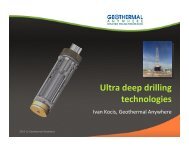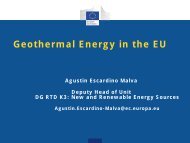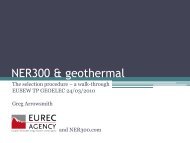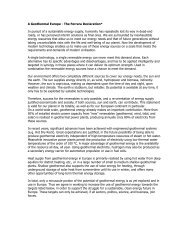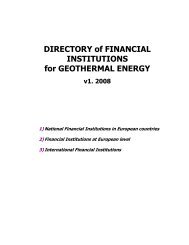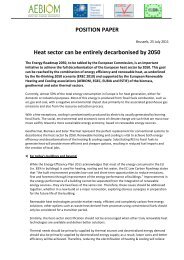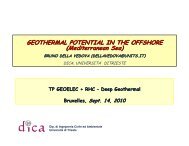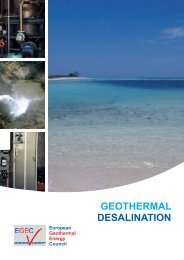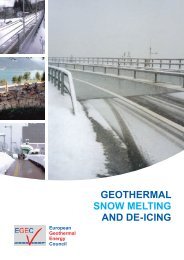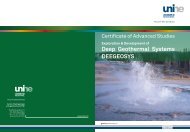Strategic Research and Innovation Agenda for Renewable ... - EGEC
Strategic Research and Innovation Agenda for Renewable ... - EGEC
Strategic Research and Innovation Agenda for Renewable ... - EGEC
You also want an ePaper? Increase the reach of your titles
YUMPU automatically turns print PDFs into web optimized ePapers that Google loves.
6<strong>Strategic</strong> <strong>Research</strong> <strong>and</strong> <strong>Innovation</strong> <strong>Agenda</strong> <strong>for</strong> <strong>Renewable</strong> Heating & CoolingDistrict Heating <strong>and</strong> Cooling<strong>Renewable</strong>Heating & CoolingEuropean Technology Plat<strong>for</strong>m6 District Heating <strong>and</strong> CoolingThe fundamental idea behind modern District Heating <strong>and</strong> Cooling (DHC) is to use local heat,cold <strong>and</strong> fuel sources that under normal circumstances would be lost or remainunused. District heating, figuratively <strong>and</strong> literally speaking, provides the pipeline connectingthese local thermal sources with heat dem<strong>and</strong>, thereby reducing energy losses <strong>and</strong> thetotal volume of primary energy needed in the energy system. It is important to keep in mindthat DHC technologies are suitable <strong>for</strong> the residential as well as <strong>for</strong> the non-residentialsector, including industries <strong>and</strong> there<strong>for</strong>e advancements in DHC technology are likelyto be beneficial to any type of user <strong>and</strong> to have positive impact on the energy technologiespresented in the previous Chapters of this publication.As energy <strong>for</strong> DHC is generally generated centrally <strong>and</strong> on large scale, it can <strong>for</strong> instanceintegrate renewable sources that are difficult to manage in small boilers. This includes mostcombustible RES such as wood waste, straw <strong>and</strong> olive residues, <strong>and</strong> also waste sources likemunicipal waste <strong>and</strong> sewage sludge. Various biomass, geothermal, <strong>and</strong>solar resources can be effectively integrated into the district heating network by meansof different techniques.25100Domestic (12 kW th )Small commercial (100-200 kW th )2080Large commercial (350-1,500 kW th )%15TWh60Small industry (100-1,000 kW th )1040Large industry (350-5,000 kW th )52020 202201990 1995 2000 2005 2010 2015 20200Figure 35: Share of renewable energy in DHC (Source: data provided by Euroheat & Power)2010 2020The current district heat supply <strong>and</strong> distribution networks are appropriate <strong>for</strong> current1levelsof heat dem<strong>and</strong>, but with the increase of renewable energy supply <strong>and</strong> the decrease of finalheat dem<strong>and</strong>, DHC must continue to evolve within its context to continue representing a smart,sustainable <strong>and</strong> inclusive 100 solution. In future the 4 th generation of distribution networks willbe characterised by the capacity to operate with lower <strong>and</strong>/or more flexible temperaturesTemperature (˚C)Flexibility(Figure 36). This key change will allow both lower distribution heat losses <strong>and</strong> higher utilisationof available RES such as solar, biomass <strong>and</strong> geothermal energy.50l4-9EUR/GJSmall industry(100 - 1,000 kW)4-9EUR/GJLarge industry(350 - 5,000kW)01870 1920 1970 2020060%High temperatureheat (>400˚C)Medium temperatureheat (100˚C - 400˚C)High temperatureheat (



